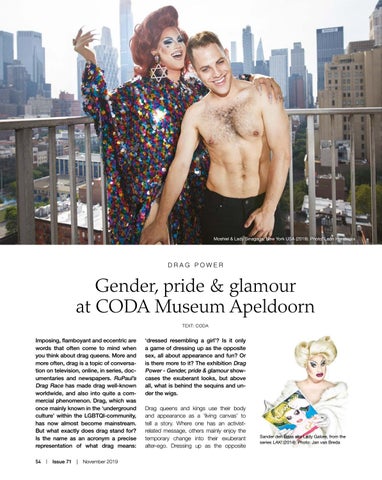Moshiel & Lady Sinagaga, New York USA (2019). Photo: Leon Hendrickx
DRAG POWER
Gender, pride & glamour at CODA Museum Apeldoorn TEXT: CODA
Imposing, flamboyant and eccentric are words that often come to mind when you think about drag queens. More and more often, drag is a topic of conversation on television, online, in series, documentaries and newspapers. RuPaul’s Drag Race has made drag well-known worldwide, and also into quite a commercial phenomenon. Drag, which was once mainly known in the ‘underground culture’ within the LGBTQI-community, has now almost become mainstream. But what exactly does drag stand for? Is the name as an acronym a precise representation of what drag means: 54 | Issue 71 | November 2019
‘dressed resembling a girl’? Is it only a game of dressing up as the opposite sex, all about appearance and fun? Or is there more to it? The exhibition Drag Power - Gender, pride & glamour showcases the exuberant looks, but above all, what is behind the sequins and under the wigs. Drag queens and kings use their body and appearance as a ‘living canvas’ to tell a story. Where one has an activistrelated message, others mainly enjoy the temporary change into their exuberant alter-ego. Dressing up as the opposite
Sander den Baas aka Lady Galore, from the series LAK! (2014). Photo: Jan van Breda
